An affectionate dog breed with the classic characteristics of a companion dog, the Maltese are well-known for their fancy coat and rather posh gait. This is a breed that wouldn’t be out of place in a palace, yet they’re adaptable and accessible enough to be found almost anywhere in America. We take an in-depth look into Maltese dogs and why they offer so much, in such a small package, below.
Dog Breed Overview
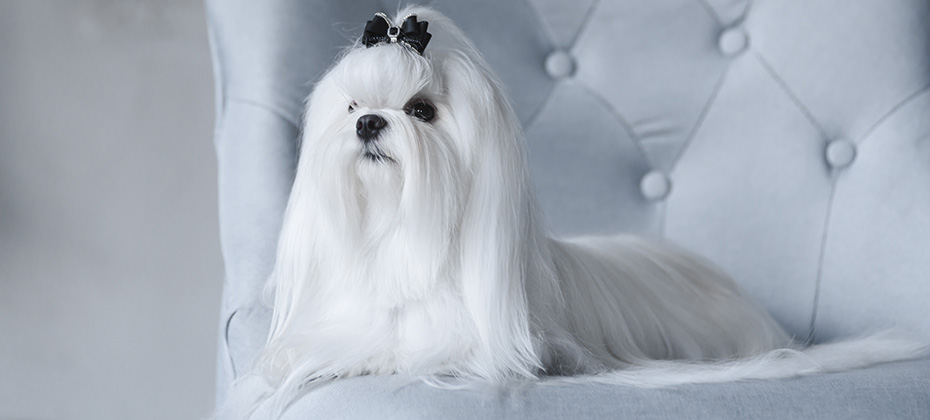
| Dog Breed Group | Height | Weight | Life Expectancy |
|---|---|---|---|
| Toy Breed/Companion Dog | Between 8 and 10 inches | Up to 7 pounds | 12 to 15 years |
An energetic and playful pup whose pet parents would do well to remember that this dog breed is so much more than a good-looking canine companion. This toy dog breed also does well in agility, obedience and tracking, making the Maltese one of the most versatile companion dogs in the world.
History of the Maltese
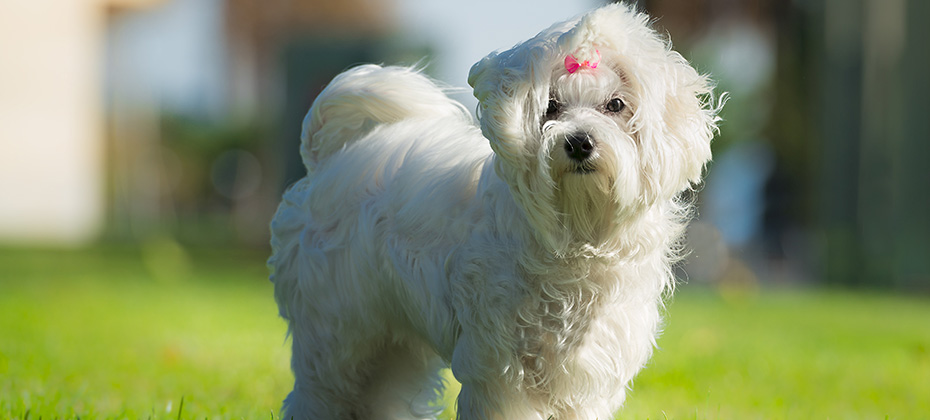
Where Does the Maltese Come From?
The Maltese dog is an ancient breed that hails from as far back as 3500 B.C.E. They have been immortalized by writers, poets and artists from Greece to Egypt, with the former even building tombs for this beloved lap dog. It is said the Egyptians believed that the Maltese had the ability to cure pet parents of diseases, and would often place the Maltese dog on the pillow of those who were ill, earning them the name of ‘The Comforter’.
They later made their way through other areas of Europe, thanks to their home of Malta, which is based just off the isle of Sicily. This is one of the reasons why they are so widespread today, as this was a port that was home to every merchant and traveller the world over. In particular, the island was used by Romans, Greeks, Carthaginians, Arabs and Normans, and it wasn’t long until the dog piqued the interest of traders who took the Maltese puppies as far as England and China.
Indeed, it was the Chinese who kept the Maltese dogs from extinction during the Dark Ages. They crossed Maltese dogs with other, more refined breeds, and brought home the distinctly distinguished dog breeds back through to Europe. Thus, the Maltese dog as we know it came to be.
The Maltese Terrier, as it was known in England, was later entered into the Westminster Kennel Club shows and their popularity boomed. They were soon taken across the pond to America, where they were accepted into the American Kennel Club around the 1950s. They have since won ample awards within the AKC, including ‘Best in Show’, where they are known to have an excellent record.
What Were Maltese Bred For?
Maltese dogs have been known, since their origins in Malta, to be companion dogs. While they may have changed since their origins in the ancient ports of Malta, they have since grown to become more than just a pup worth bartering for. Pet parents of Maltese dogs know that this dog breed makes for exceptional entrants into American Kennel Club competitions.
The Maltese dog breeds are hardy and adaptable canine companions, often excelling in AKC agility competitions, as well as obedience, tracking and rally. This is one of the rare dog breeds that can excel in almost any area – as long as they are well-trained and given lots of care. They are often even used as a therapy dog, a tradition that goes back as far as their heritage on the Island of Malta.
Few More Words About Maltese
How Long do Maltese Live?
Maltese dogs have a healthy life span of up to 15 years, as long as they are well-cared for. Pet care for the Maltese includes ensuring their exercise requirements are met, and they are given plenty of love and affection by their owners.
Are Maltese High Maintenance?
Maltese dogs are not a breed that is compatible with a busy lifestyle, unless you can bring your dogs along with you on your adventures. This dog breed wants to be beside its owner at all times, and their desire to be close by is driven by an undying loyalty to their pet parents.
Maltese are prone to getting under the feet of their humans, they can be picky eaters and their coat requires regular grooming, all of which add up to become a time-consuming aspect of owning these lovable pups. Of course, for those familiar with the breed and who have time to dedicate to Maltese ownership, these concerns should not be a problem.
Maltese Dog Breed Appearance
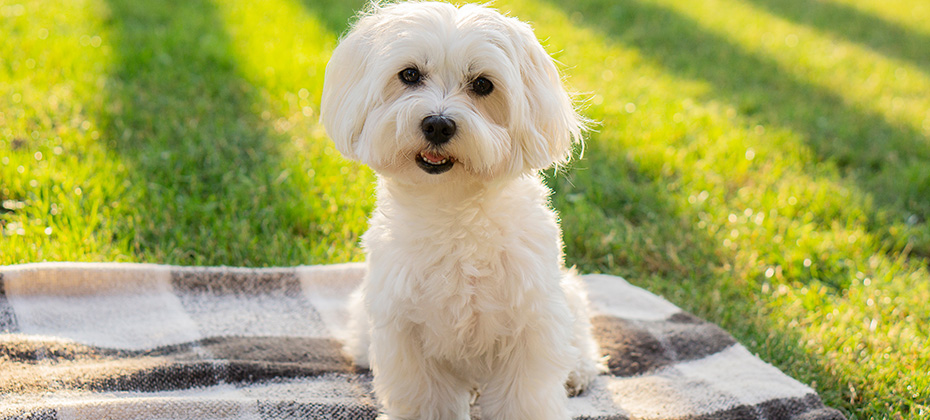
How Big Do Malteses Get?
The Maltese dog breed is not a large dog, and they can often only reach up to 10 inches at the shoulder. They are also extremely light, with their weight only reaching up to 7 pounds. Indeed, the majority of the Maltese is made up of their hair, with their long coat being one of their most eye-catching factors. Owners should therefore be careful to watch the weight of their dogs, as the breed can easily put on weight without the right level of exercise.
What Does a Maltese Look Like?
One of the biggest factors to what a full-grown Maltese looks like is their hair. Covered from head-to-toe in a long, silky, white coat, many owners who are not seeking to enter their dog into the AKC competitions simply choose to cut this hair to make it more manageable for everyday living. There is only one coat color that is recognized by the AKC, which is white.
The ears of the Maltese are fairly low on the rounded skull, with the head itself being in perfect proportion to the body. Their height is very small, coming up between 8 and 10 inches at the shoulder, and their build is always fairly even across the entire body.
The tails of the Maltese dogs will sit over the back and curl slightly to one side, sitting over their legs. At the same time, their gait is even and they often confidently stride alongside dog owners without issue, despite their small height and weight.
Interesting Facts
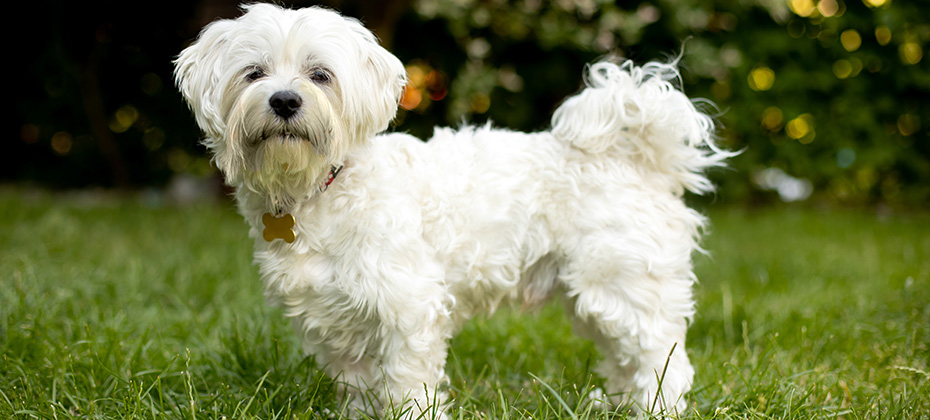
- Allergy sufferers will be please to know that the Maltese is a hypoallergenic dog
- Their nose can turn pink if they don’t get enough sun.
- They are people pleasers and love to be trained
- Their name hails from their origins, from the island of Malta.
- Maltese dogs have been owned by royalty all over the world.
- It is believed their white fur was bred into them by Romans, who felt that white emanated divinity.
- They have a habit of jumping – so you may want to keep your valuables on high shelves!
- One Maltese, named Take Trouble, was worth $2 million, after their owner left all of their assets to their pet, in their will.
Maltese Dog Temperament
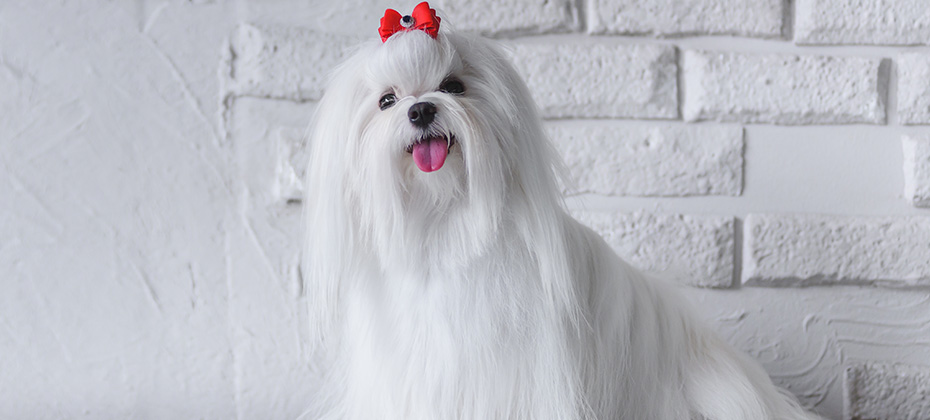
Ideal for those who have an interest in entering their dogs into a dog show, as well as those who simply want a lap dog for the family pet, these dogs are incredibly versatile. This is one of the reasons why the Maltese is one of the most popular dogs, to date.
What is Maltese Behavior Like?
Maltese dogs have high exercise needs and will appreciate lots of playtime and long walks with their owner, despite their small size. Without this, the breed can sometimes become a little overly boisterous and become difficult to manage. Despite this, however, they are also very likely to be lap dogs, and often want to do nothing more than simply be with their owner, earning them the title of a Velcro dog.
The classic characteristics of the Maltese dog are as being affectionate, playful, sensitive, intelligent and people-oriented. This level of interest and adaptability means that your Maltese will constantly need new things to help keep their attention. The good news, however, is that they are quick to pick up new things, making them some of the top picks for learning tricks and are regularly entered into various types of the classic dog show.
How Friendly are Maltese?
Maltese dogs are incredibly friendly, though they should still be well-socialized from a young age to help them become used to the different sights, sounds and smells that your dog might come across during their life span.
This dog breed is extremely friendly and affectionate toward family members, and they can get along well with other dogs and children, though they may need some time to get used to cats. They are, however, distrusting of strangers and anyone new to the home will need to approach owners before they approach your dog.
Do Maltese Like to Cuddle?
The Maltese are a dog breed that is known for their companionship, and when their exercise requirements for the day have been met, you’ll soon find that your dogs want nothing more than to cuddle up with their owners.
Due to their need to be close to their owners at all times, they are one of the easiest breeds when it comes to pet care – where pet care refers to grooming and handling. Unfortunately, their desire to be around pet parents at all times also means they can suffer with separation anxiety. For this reason, it’s important to note that Maltese owners should be willing to be with their dogs for the majority of the day, or seek to train their dogs so that they do not suffer with anxiety when their owner is busy.
They are ideally suited toward busy households, filled with other dogs, animals and people. After all, they hail from Malta – one of the busiest ports that existed, meaning that their background has always had them surrounded by others.
Maltese Care
Want to know how to get the most from your Maltese dog? Knowing how to care for your dog breed can make the difference in finding the right pets for your household and struggling with long-term issues that can arise from the breeds. Below, we cover everything you need to know and give you the essential Maltese information you need to make the right choice for your needs, ensuring you and your home are happy well into old age.
Training
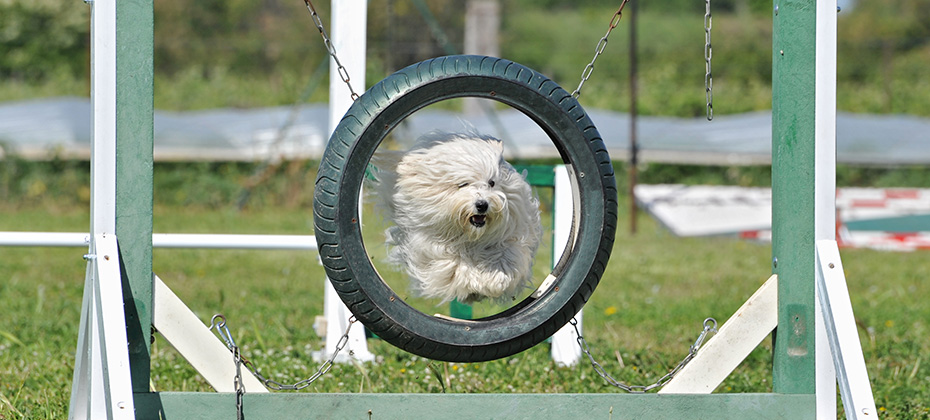
Training a Maltese dog is remarkably easy, with the breeds quickly picking up dog sports and general commands without a problem. Adult dogs are well-known for taking part in the AKC dog shows, with obedience and agility being just some of the show types they can excel in.
As owners would find with any dogs, the Maltese needs consistent training, in order to use up their high level of intelligence. Lots of positive reinforcement will quickly ensure that your dog is able to meet even the most stringent AKC requirements, which is possibly why the Maltese has often taken home the award of ‘Best in Show’ at various AKC and independent dog shows.
Due to their small size, however, you might notice that potty training a Maltese can be more difficult than with other breeds. It is recommended that indoor training is recommended – particularly for those who live in apartments – as their small bladder can quickly become full.
Maltese dogs are also a little aloof with strangers, and will need regular socializing from a young age if you want your dog to become more friendly with unknown people around the home. Taking them to puppy training classes from a young age can help your dog become used to a higher level of different sights, smells and sounds that come from regular outings. Thus, with a proper level of socialization, you’ll soon find your Maltese dog is much happier and healthier well into old age.
Feeding
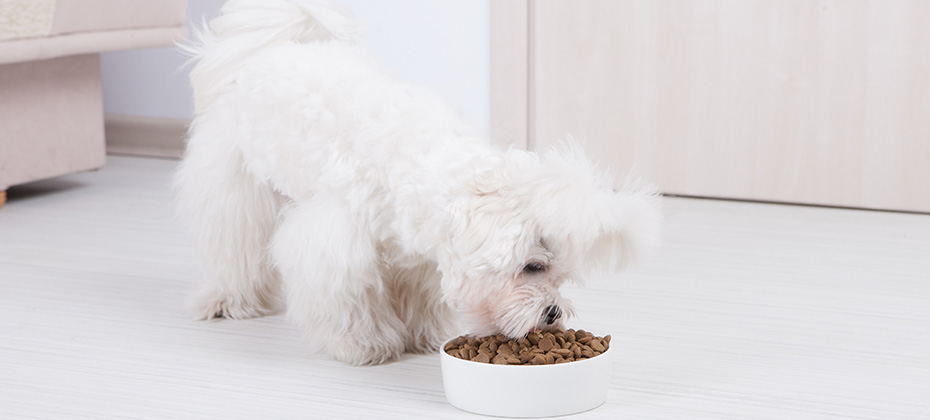
Due to their smaller size, the Maltese eat far less than most other dog breeds. Between 1/4 cup and 1/2 cup of high-quality dog food is often all that is needed to keep these dogs happy. This should be divided into two servings of morning and night. However, every dog is unique and it is always worth considering the overall weight of your adult dog.
Puppies will need to eat a little less, though they will still keep their puppy fat, but as they get older it is worth keeping an eye on the level of food you provide. The best way to do this is to run your hands over the stomach area, between the ribs and legs of your dog, as they are in a standing position. If the stomach is protruding, this is a sign that they may be putting on too much weight, so you will need to feed them less.
Similarly, if you can feel your dogs’ ribs as you stroke them, this is a sure sign that they are underweight and you should adjust the level of food you are feeding them accordingly, increasing by 1/8th of a cup until they reach their optimum fat levels. The ideal size for the Maltese are those with a slightly indented stomach so that you can spot a slight incline from the legs and ribs toward the stomach.
Maltese are known for being picky eaters, so it may take some time to find the right food for your dog. Try switching between different brands of dog food, but be sure to always gradually change over the dog food of choice, each time, at a rate of a quarter each day.
You may also like our article on Dog Food for Maltese.
Grooming
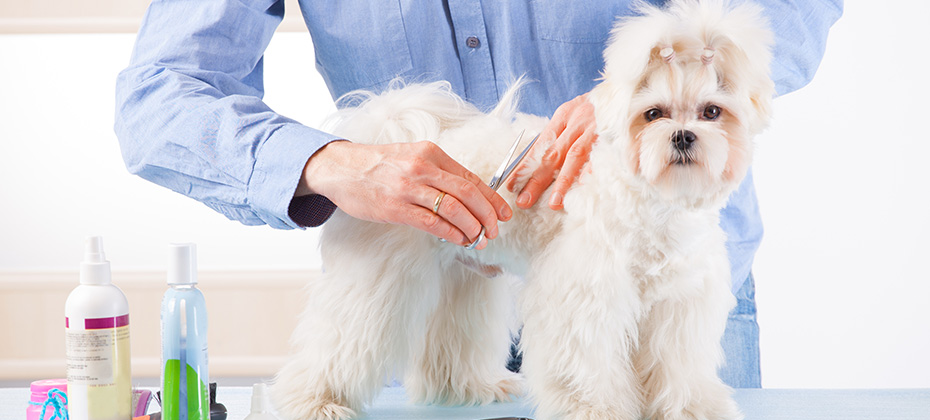
If you decide to keep the hair of your Maltese longer, then be prepared for lots of grooming – particularly with the playful adult dog, who is more likely to get into the mud and become dirty during playtime. It is also important to note that the hair of the Maltese is made up of a single coat, with no under-coat to help keep them warm, so they don’t tolerate cold weather very well.
Tear staining is a common problem with adult Maltese dogs. Tear stains appear as a brown, red or pink marking around the eyes, toward the muzzle. Tear staining is especially common in dogs with a white coat and is due to liquid leaking from the eyes, naturally. It is not harmful to your dog but can give them a dirty look that some owners prefer to clean up using a specialist remover for tear stains that do not harm the eyes.
Check out our guide on Dog Tear Stain Remover.
In order to keep your pet hair at its healthiest, daily brushing of the coat is required. Without this, their coat is likely to mat and become tangled. Use a soft-bristled brush around the face, eyes and ears so as not to scratch the delicate skin of your Maltese, while a stiff-bristled brush should be more than enough to run through the hair of your dog without causing any issues.
Maltese breeds also need regular bathing, at a rate of roughly once a week, using dog-friendly shampoos. Be careful not to get any soap or water near to their eyes, as this can cause distress to your pet. Owners of these breeds should also be sure to trim their pet’s nails regularly and brush their teeth daily – especially as the Maltese are known for suffering from dental issues as they age.
Health

Maltese dogs are generally a healthy breed, as long as their exercise needs are being met. Unfortunately, like all pets, the Maltese do have some health problems that owners should understand and be ready to identify symptoms of, including those below.
- Progressive Retinal Atrophy
Progressive Retinal Atrophy (or PRA) is a degenerative illness that affects the receptors of the eyes. It eventually leads to blindness and is most common in older dogs. There are two different forms, one of which is inherited, so it’s important to ensure that your breeder has checked and ‘bred-out’ this form before you buy your Maltese.
- Sebaceous Adenitis
One of the most common health problems found in a wide range of dogs, Sebaceous Adenitis is the inflammation of the oil glands found underneath the skin. It is signified by dry, scaly patches on your dog’s skin and quickly leads to hair loss across the back and head of the Maltese dog. It is easily treatable, and treatments can range from steroid injections through to supplements – but it does require early attention from the vet, so be sure to get this checked out if you suspect skin problems.
- Hypothyroidism
Another common problem that can be found in a range of breeds, hypothyroidism is when the body does not make enough of the thyroid hormone, thyroxine. Behavioral changes, combined with skin disorders, are some of the most common symptoms and treatment is easily administered through a thyroxine pill taken once a day.
- Tracheal Collapse
If you notice your dog struggling with coughing or breathing, it could be due to a tracheal collapse. This is where the rings that help to ensure the trachea (throat) is kept open and firm, can become loose and fold inwards. In severe cases, surgery is recommended.
- Deafness
Another excellent reason to ensure you buy your Maltese from a responsible breeder is deafness. Naturally, this affects the ears and can be caused by a genetic mutation that leads to a complete loss of hearing. If you notice an increased startle reflex when you come round the back of your dog, or they begin to bark excessively, this could be due to a loss of hearing.
- Shaker Syndrome
Found in all dogs with a white coat, Shaker Syndrome is an inflammation of the cerebellum (the part at the back of the brain that is responsible for voluntary muscle movement) and causes your dog to shake involuntarily. It can sometimes occur as the result of an infection, and treatment focuses on lessening the symptoms as the cause cannot always be identified.
Exercising
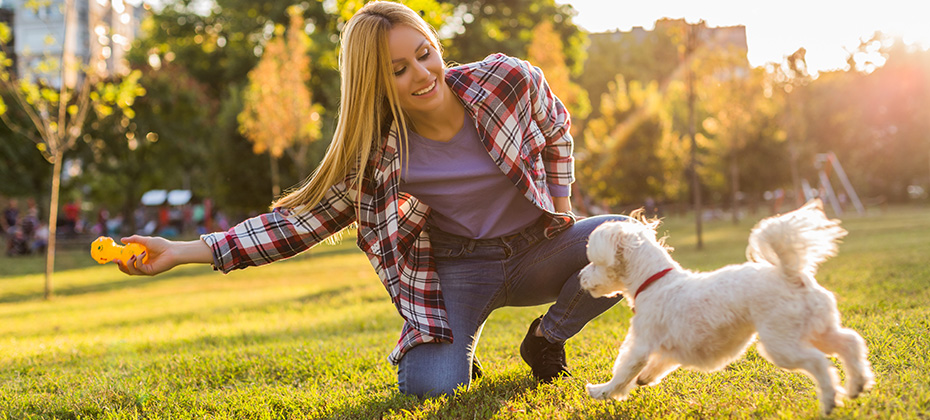
Maltese dogs have high exercise needs and require plenty of playtime and walks to help them keep their energy levels at bay. Despite their small size, these pets need plenty of physical and mental stimulation to keep them happy, especially as they are known to suffer from separation anxiety. An adult Maltese should be walked at least once a day, and ideally be given lots of access to the outdoors in the form of a yard, in order to stretch their legs regularly.
Adopt Don’t Shop (Rescue Groups)
We would always recommend adopting your Maltese, so feel free to browse through the local adoption centers to see if there are any Maltese dogs you can rescue. If, however, there are none available locally and you are keen to adopt these Malta-born dogs, browse through the American Maltese Association Rescue website to see if there are any in need, near you. Similarly, the American Maltese Association will often know of some local Maltese who are in need.
Both of these sites also have plenty of breed-specific information, so feel free to browse through these sites to learn more.
Reputable Breeders
Finding the right Maltese puppy can take a lot of research, to find the right Maltese breeder for your needs. Remember that all dogs are individual, but finding the Maltese with the right level of exercise requirements that suit your home, as well as those that make the best pets for your household, requires time and energy in itself.
Some of the things that should always be considered, when finding your pets, is whether the breeder of these dogs has bred any health issues out of the lineage. You should always be able to see the parents of your pets, before buying and a good breeder should be happy to answer any questions you may have.
If you’re looking for a Maltese to take part in dog sports, or to register with the American Kennel Club, it is worth ensuring that the parents are also AKC-registered white Maltese types. Any other coloring is not accepted by the AKC, and therefore should be carefully considered.
Check out: Maltese Puppies for Sale
Price
Maltese are a highly sought-after breed and prices can therefore range from around $800 to $1500. Before purchasing, do browse local sites to see if there are any good adoption shelters near you, or be sure to browse through reviews of breeders, to ensure your pets are as healthy and happy as they can be, before coming home with you!
Sources:
- Debra Ronca, Are Maltese Good Family Dogs?, HowStuffWorks
- Maltese, VCA Hospitals







